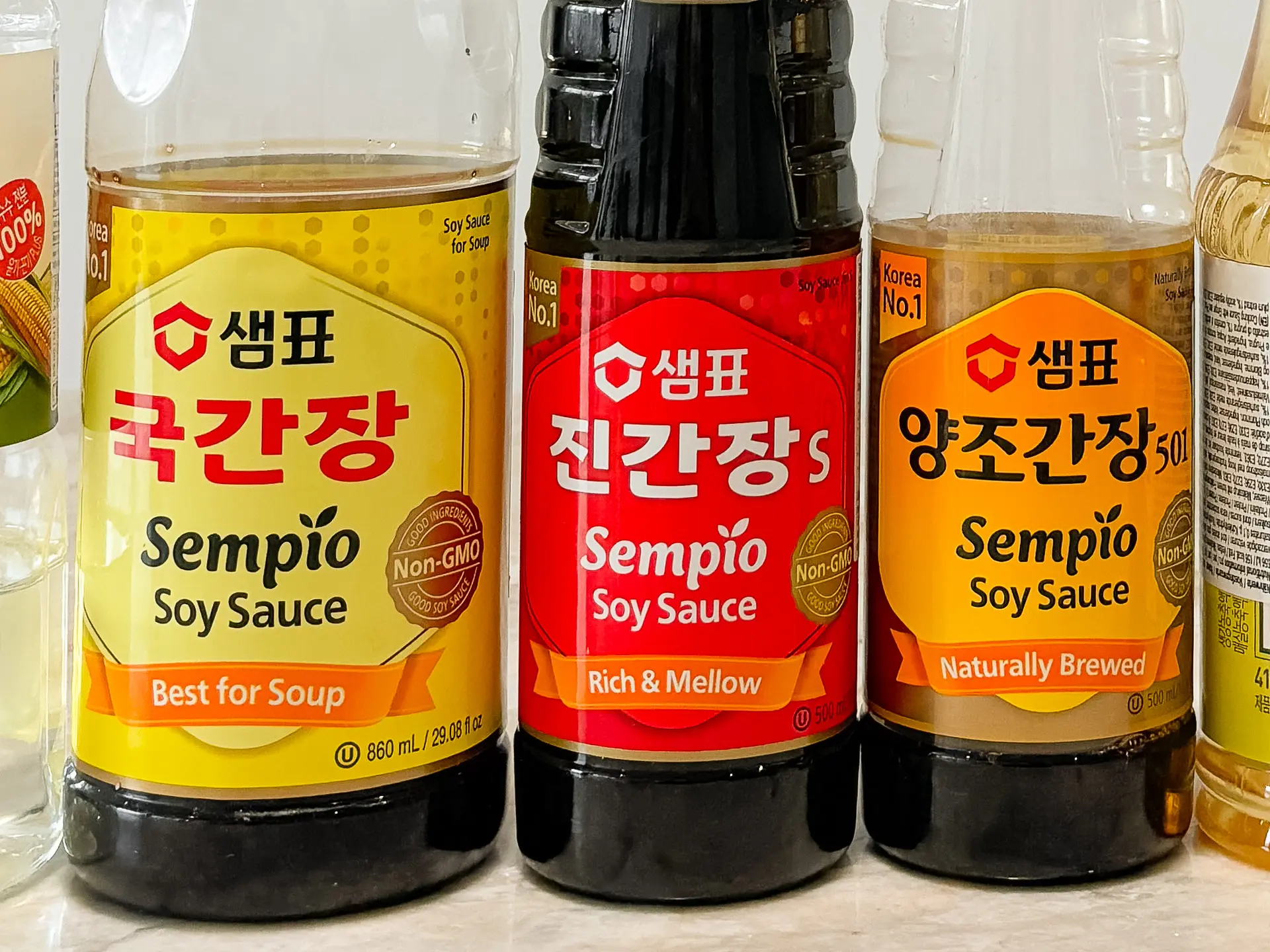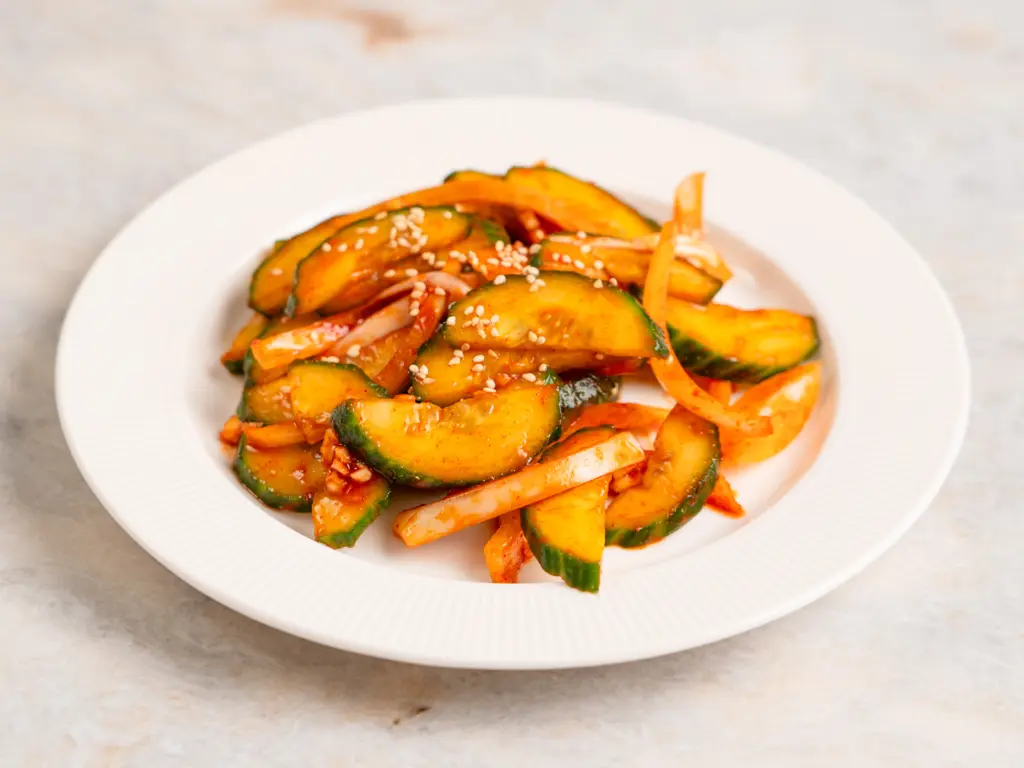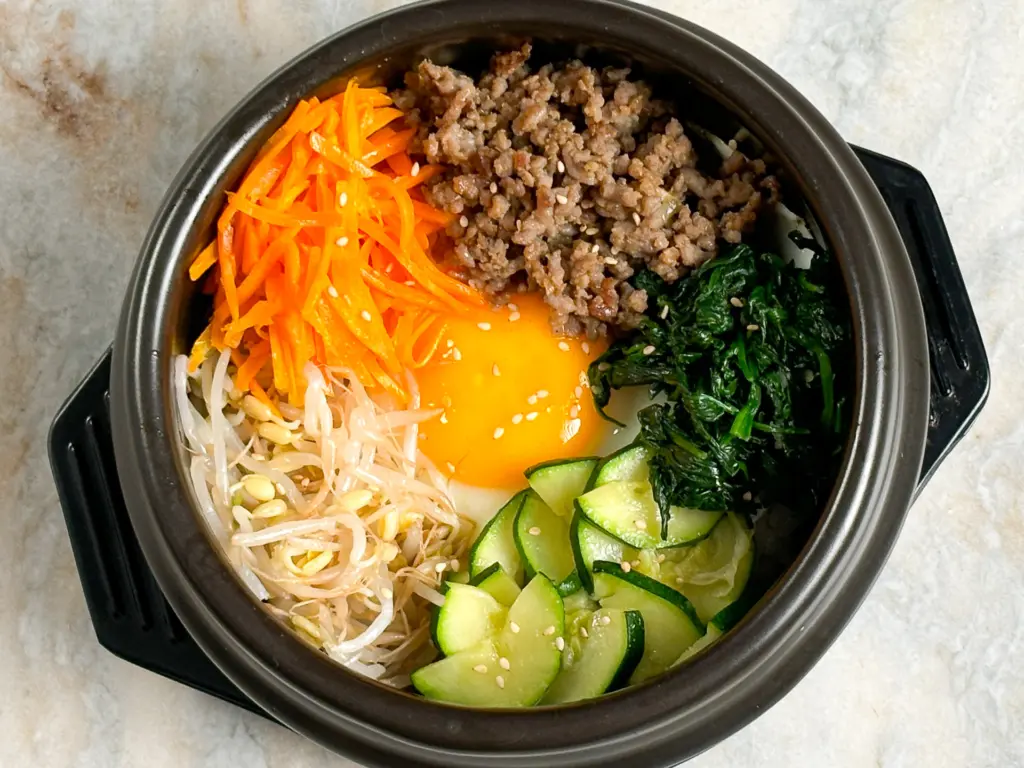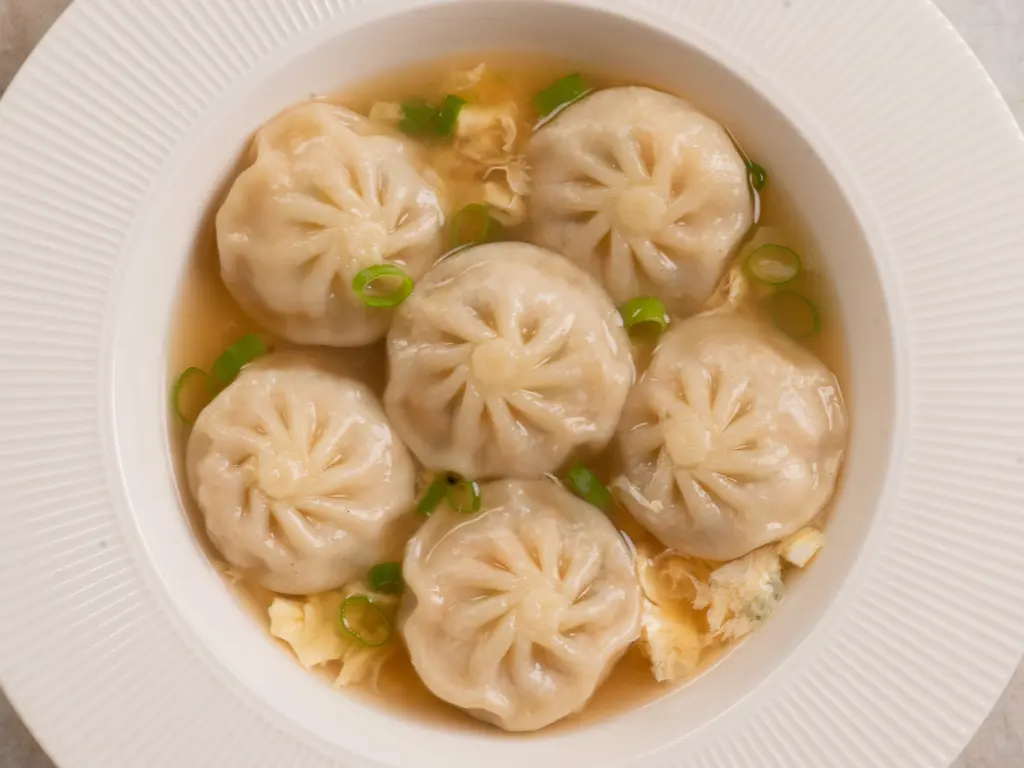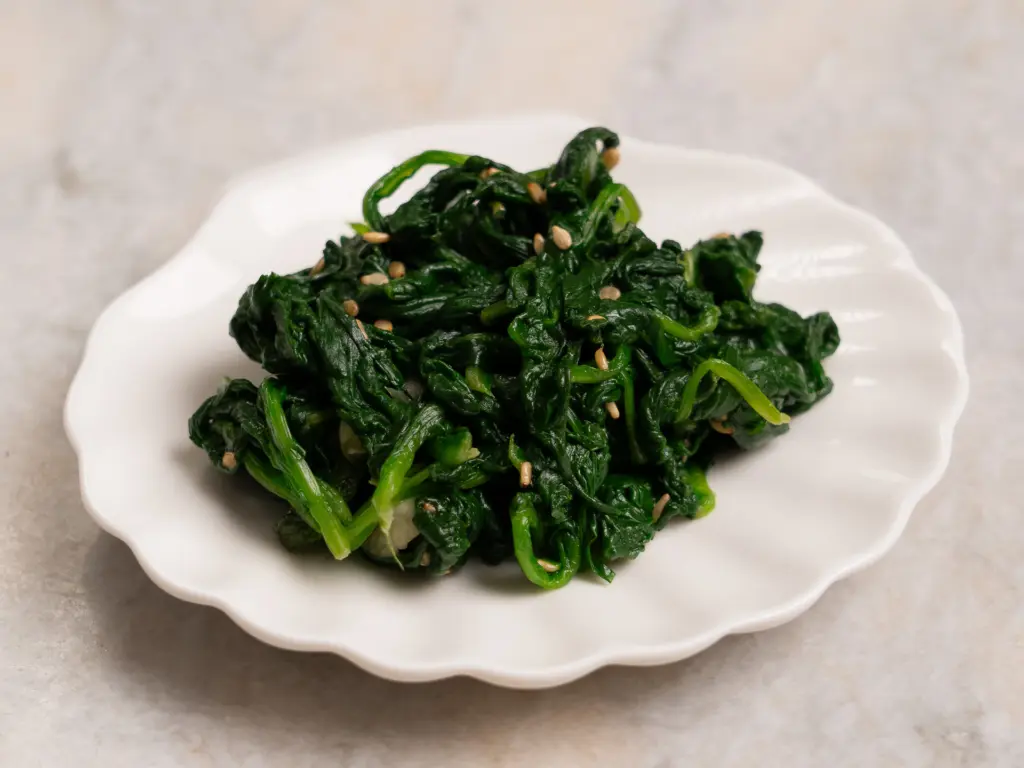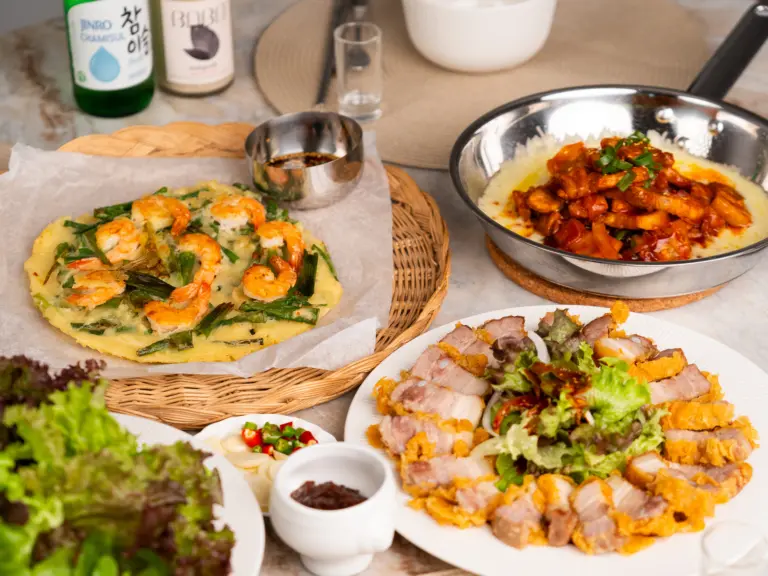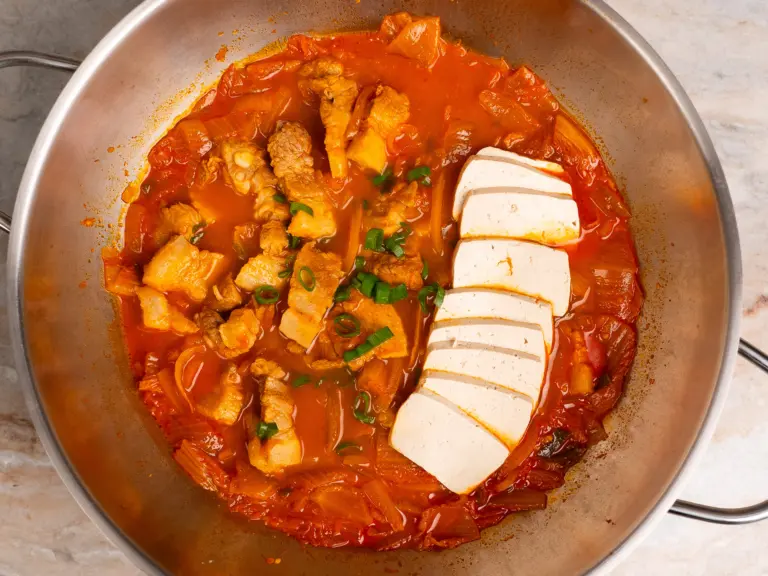Korean Soy Sauce Guide: Choose the Best Ganjang for Korean Cooking
Not sure which Korean soy sauce to buy? Wondering which one you need for bulgogi sauce, bibimbap sauce, or Korean soup? This post will tell you everything. By the end, you’ll know exactly which Ganjang to choose for your Korean food.
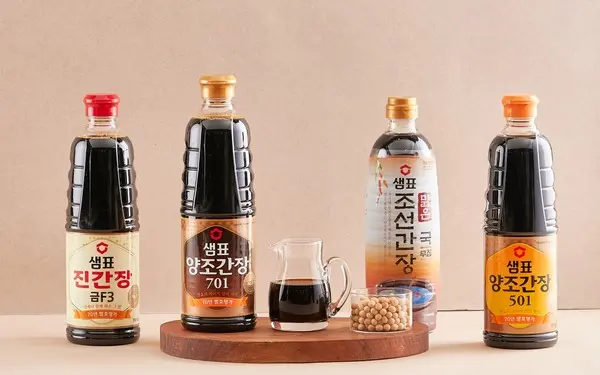
What is Korean Soy Sauce?
Soy sauce is a dark brown, salty liquid seasoning made by fermenting soybeans in brine. It’s not only found in Korea but also in Japan and China. Beyond adding saltiness, soy sauce enhances umami and aroma, making it an essential ingredient in Asian cuisine.
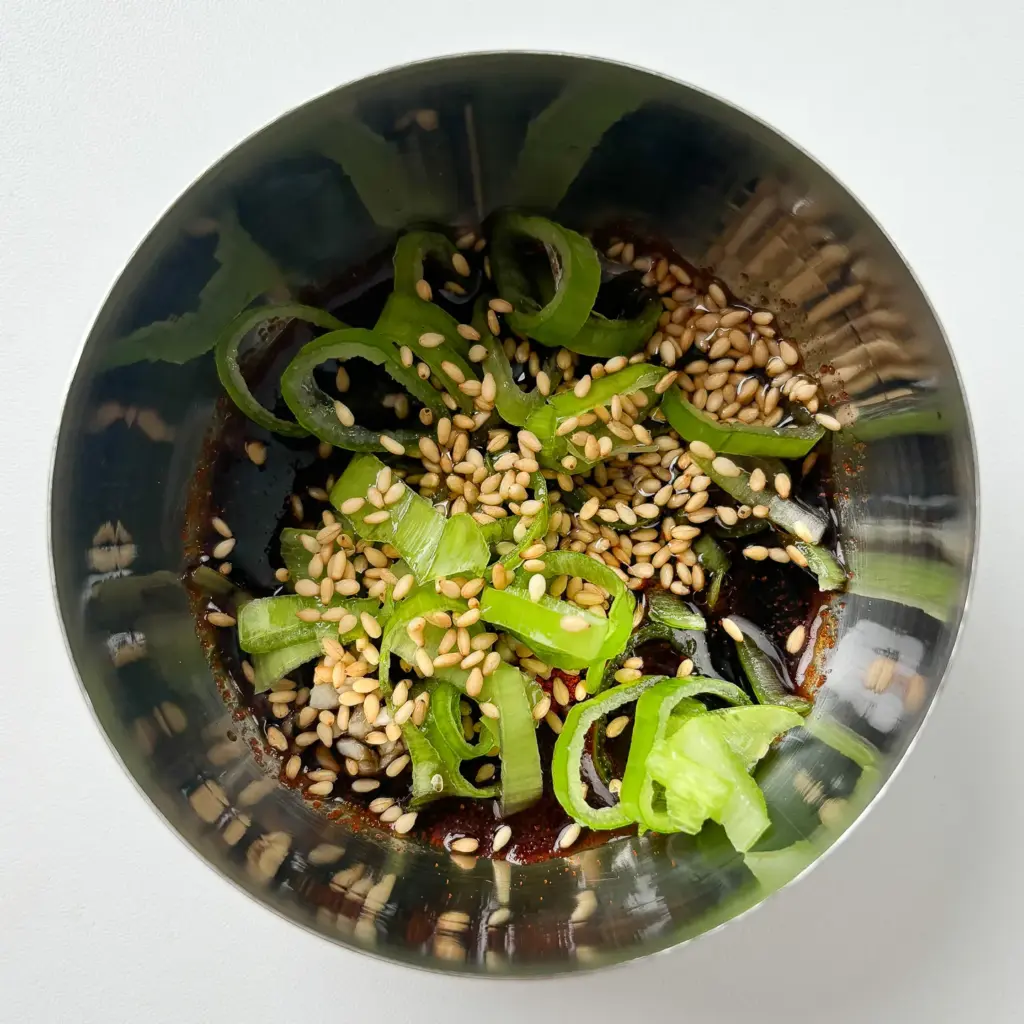
Korean soy sauce comes in three main types, Jin Ganjang, Yangjo Ganjang, and Guk Ganjang. Each has a different flavor, color, and aroma, and they’re used in different kinds of dishes. In this post, I’ll explain each type and share recipes that use them.
Soy Sauce in Asian Cooking
Korean Soy Sauce
Korean soy sauce is made by forming soybeans into meju (fermented soybean blocks) and fermenting them in brine. The fermentation period is relatively long. Using traditional fermentation, Guk Ganjang is made, while Jin Ganjang and Yangjo Ganjang are produced through hydrolysis or a mixed process. Korean soy sauce has a strong salty taste with little sweetness, and its flavor is deep and rich.
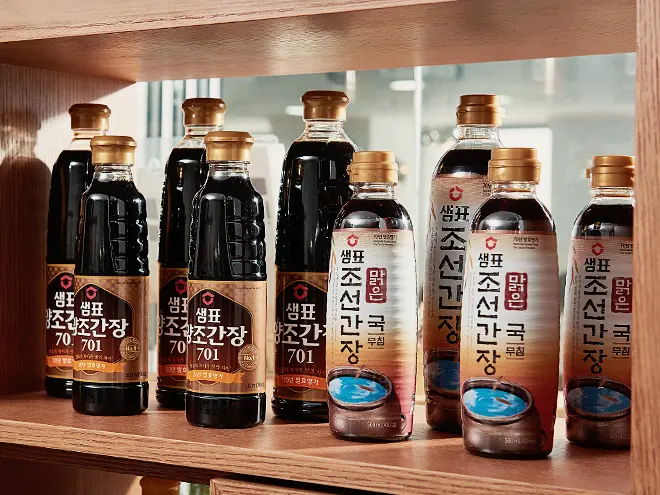
Japanese Soy Sauce
Japanese soy sauce is made by fermenting soybeans and wheat. The fermentation period is shorter than in Korea. Japanese soy sauce has both salty and sweet flavors, making the taste milder and the color lighter.

Chinese Soy Sauce
Like Korea, Chinese soy sauce is made by fermenting soybeans formed into meju in brine. The difference is that wheat-based qu is added to the soybeans before fermentation. There are two main types: light soy sauce (sheng chou), which has a lighter color and flavor, and dark soy sauce (lao chou), which has a darker color and a sweeter taste, often used to color dishes.

The 3 Main Types of Korean Soy Sauce
Yangjo Ganjang (Korean Brewed Soy Sauce) 양조간장
Yangjo Ganjang is made by fermenting meju (soybean blocks) made from soybeans and wheat over a long period. It is ideal for stir-fries, salads, and sauces.

This Korean soy sauce has a deep color and a strong salty flavor with a hint of sweetness. It is known for its rich aroma, which can include fruity, fresh, and slightly alcoholic notes, making it perfect for dishes that require a complex soy sauce flavor. Since heat can reduce its aroma, it works best in lightly cooked stir-fries, like japchae, or in no-heat dishes such as muchim, as well as in dressings and dipping sauces.
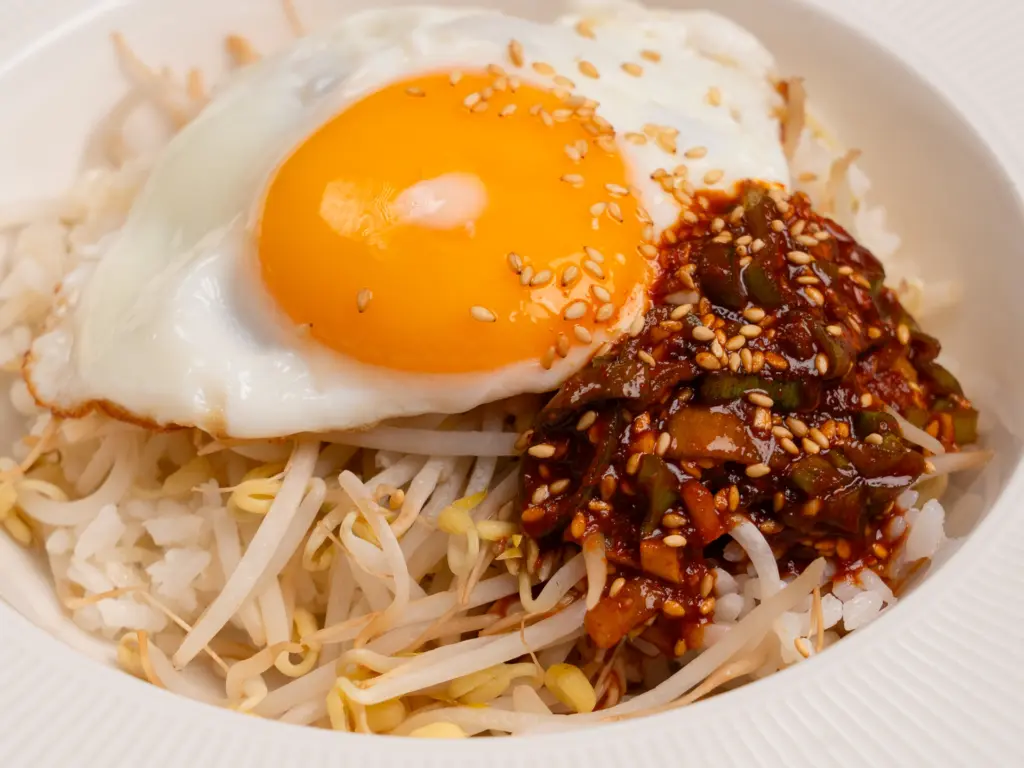
Yangjo Ganjang bottles often have numbers like 501 or 701 printed on them. These numbers indicate the nitrogen content. The higher the nitrogen content, the more natural flavor compounds it contains, resulting in a richer taste and aroma.
Korean Food Recipes Using Yangjo Ganjang
Oi Muchim (Korean Spicy Cucumber Salad) 오이무침
One of Korea’s most basic side dishes, Oi Muchim, is made by mixing cucumbers with chili powder, Korean soy sauce, sugar, and vinegar for a spicy, tangy, and slightly sweet flavor. Since this dish does not require heat, using fragrant and slightly sweet Yangjo Ganjang is ideal.
Korean Mom’s Spicy Cucumber Salad (Oi Muchim)
Korean Hot Pot with Cabbage 배추찜
This healthy hot pot combines napa cabbage and pork. The highlight is the dipping sauce for vegetables and meat, which is tangy, sweet, and has a kick of wasabi. The best Korean soy sauce for this dipping sauce is the aromatic and slightly sweet Yangjo Ganjang.
-20kg Weight Loss Steamed Cabbage with Pork Belly, Korean Hot Pot
Bibimbap 비빔밥
Did you know that Korean soy sauce is included in the bibimbap gochujang sauce? At home, you might notice that your bibimbap sauce is different from the restaurant version. That’s because bibimbap sauce is made with gochujang, Korean soy sauce, sugar, and other ingredients to create a sweet and umami flavor. Since the Korean soy sauce in bibimbap sauce is not boiled, using fragrant Yangjo Ganjang is ideal.
The Best Dolsot Bibimbap
Jin Ganjang (Korean Dark Soy Sauce) 진간장
Jin Ganjang is made by mixing brewed Korean soy sauce with amino acid liquid derived from broken-down soybean proteins, allowing it to be produced in large quantities in a short time. Compared to traditional Korean soy sauce, it is closer in style to Japanese soy sauce, which is why some older Koreans sometimes refer to it as “Japanese soy sauce.”

This Korean soy sauce is perfect for stir-fries, braises, and steamed dishes. It is characterized by a rich umami flavor and a deep roasted sesame aroma. Because its taste and aroma remain stable even when exposed to heat, it is ideal for cooking methods that involve boiling or simmering.
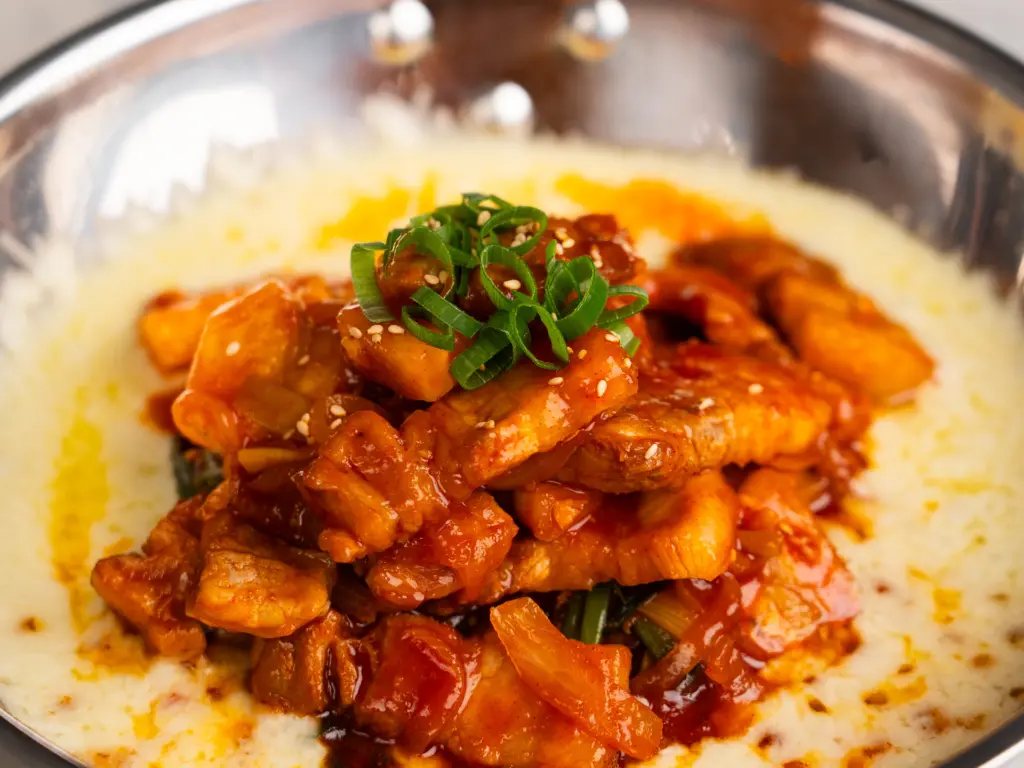
Jin Ganjang is also relatively inexpensive, making it suitable when large amounts of soy sauce are needed. For example, it works well in braised dishes like mackerel jjim or jjimdak, where Korean soy sauce is a key ingredient.
Korean Food Recipes Using Jin Ganjang
Bulgogi 불고기
This is a quick version of bulgogi that doesn’t require hours of marinating—ready in just 30 minutes. The bulgogi is simmered in a sweet and salty soy sauce broth with mushrooms and vegetables. For dishes like this, which require simmering soy sauce over high heat, Jin Ganjang is the best choice because its flavor and aroma remain intact even under heat.
Quick Ttukbaegi Beef Bulgogi. No Marinating Required!
Dakgalbi (Spicy Stir-Fried Chicken) 닭갈비
Dakgalbi includes gochujang, chili powder, Korean soy sauce, and other seasonings. Soy sauce adds both saltiness and depth of flavor. For dishes like dakgalbi that are stir-fried over high heat, using Jin Ganjang is ideal because it retains its taste and aroma even under intense heat.
Cheese Dakgalbi (Korean Spicy Chicken Stir Fry) – Famous Seoul Restaurant Style
Guk Ganjang (Korean Soup Soy Sauce) 국간장
Guk Ganjang is made from 100% soybeans using traditional Korean methods, which is why it’s sometimes also called Joseon Ganjang (Korean soy sauce for soup). Its rich, savory aroma and high salt content help reduce bitterness and harsh flavors in ingredients. Compared to Jin Ganjang or Yangjo Ganjang, it has a lighter color, making it ideal for seasoning dishes without darkening them. Using Guk Ganjang instead of plain salt can also help reduce sodium intake.

Guk Ganjang has no sweetness, and a small amount is enough to season a dish, making it perfect for Korean guk (soups). It is also great for seasoning vegetable side dishes, like blanched soybean sprouts or spinach muchim.
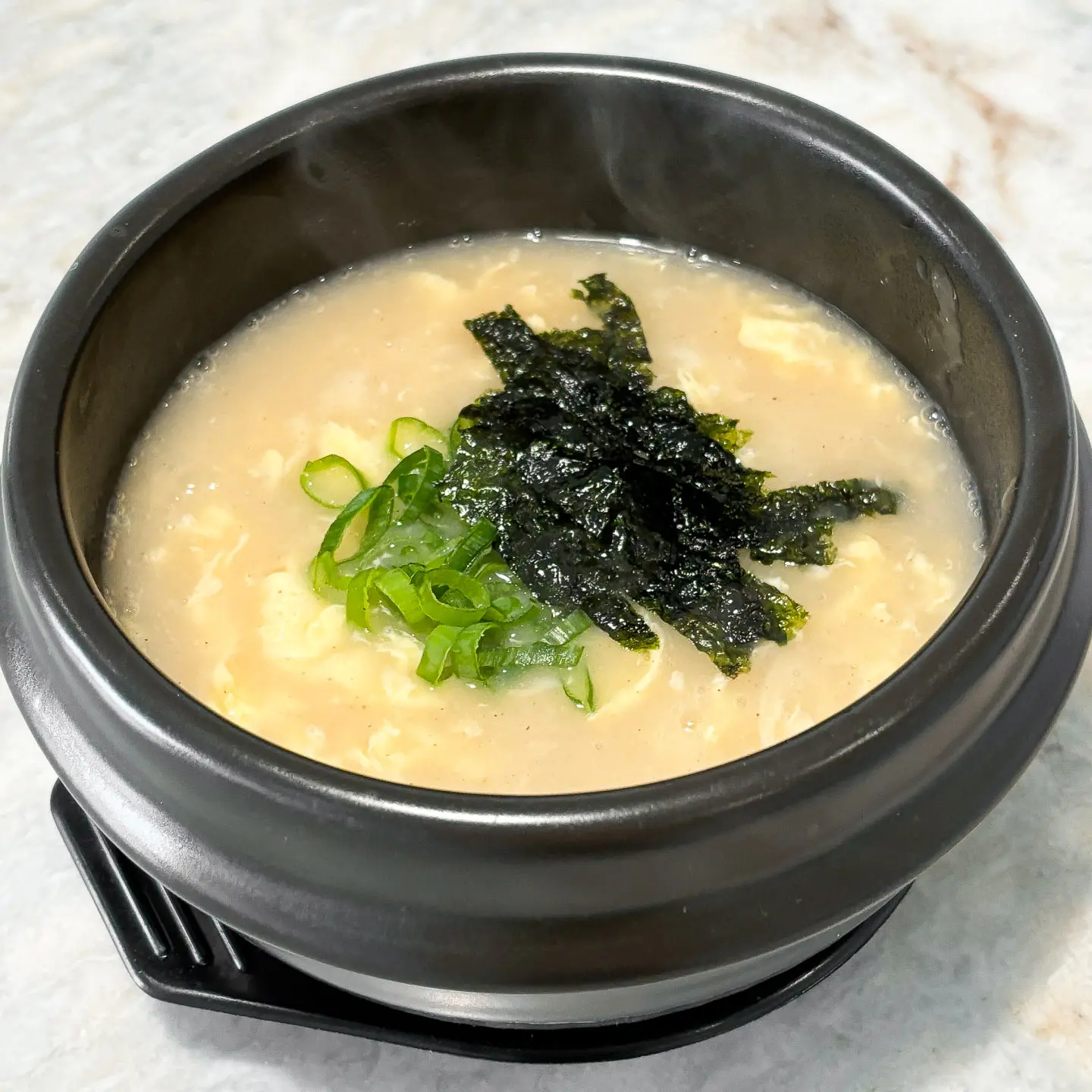
Korean Food Recipes Using Guk Ganjang
Mandu Guk (Korean Dumpling Soup) 만둣국
Mandu Guk is a soup made by boiling Korean dumplings (mandu). For this soup, it’s best to use Guk Ganjang because its light color won’t darken the broth while still providing high saltiness and a rich, savory aroma. Just one tablespoon can add enough flavor and depth to the soup.
Easy Mandu Soup: Korean Dumpling Soup with Egg (Mandu Guk)
Spinach Muchim 시금치 무침
Spinach Muchim is one of the first dishes people think of when they imagine Korean banchan (side dishes). After lightly blanching the spinach, it’s seasoned with a salty, nutty sauce. There are many variations—some use only salt, others add Korean fish sauce, and some, like in this recipe, use Guk Ganjang. Using Guk Ganjang in vegetable dishes helps maintain the natural color of the ingredients, adds a rich aroma, and enhances the umami flavor.
Spinach Banchan (Sigeumchi Muchim)
FAQs about Korean Soy Sauce
Is Korean soy sauce different?
Yes, Korean soy sauce (ganjang) is different from Japanese and Chinese soy sauces. It’s usually saltier and less sweet, with a deep, rich umami flavor. There are 3 main types, Jin Ganjang, Yangjo Ganjang, and Guk Ganjang — each used for different Korean dishes like bulgogi, bibimbap, and soups.
What is Korean soy sauce called?
Korean soy sauce is called Ganjang (간장). It’s a key ingredient in Korean cooking and comes in three main types: Jin Ganjang (진간장) for stir-fries and braised dishes, Yangjo Ganjang (양조간장) for dressings and sauces, and Guk Ganjang (국간장) for soups.
Is bulgogi sauce the same as soy sauce?
Not exactly. Bulgogi sauce is made with Korean soy sauce as its base, but it also includes sugar, garlic, sesame oil, and sometimes fruit puree for sweetness. The type of soy sauce used — usually Jin Ganjang — adds the signature savory depth to bulgogi.
What is the best soy sauce brand in Korea?
One of the most popular and trusted Korean soy sauce brands is Sempio (샘표). It’s widely used in Korean households. I personally use it, and my Korean mom does too. Sempio offers different types of soy sauces, from everyday Jin Ganjang to traditional Guk Ganjang, suitable for all Korean dishes.
Is Lee Kum Kee real soy sauce?
Yes, Lee Kum Kee is real soy sauce, but it’s Chinese-style, not Korean. Its flavor is generally sweeter and darker than Korean soy sauce, so it’s not the best substitute for authentic Korean dishes like guk or bibimbap.
What makes Korean soy sauce unique?
Korean soy sauce is unique because of its fermentation process and variety of uses. Traditional Korean soy sauce is made by fermenting meju (soybean blocks) in brine, giving it a deep, savory aroma and strong saltiness.
What is Jin soy?
Jin soy (Jin Ganjang) is a Korean-style soy sauce made by blending naturally brewed soy sauce with amino acid liquid from soy protein. It has a bold flavor that holds up well to heat, making it ideal for stir-fried and braised dishes like bulgogi and dakgalbi.
Do Korean people use soy sauce?
Absolutely! Soy sauce is one of the most essential seasonings in Korean cooking. It’s used in almost everything from soups (guk) and stews (jjigae) to stir-fries, dressings, and even dipping sauces. Every Korean kitchen has at least one bottle of soy sauce, often more than one type.
Disclosure: Blonde Kimchi is part of the Amazon Services LLC Associates Program, an affiliate advertising program that allows websites to earn advertising fees by linking to Amazon.com and promoting products.

